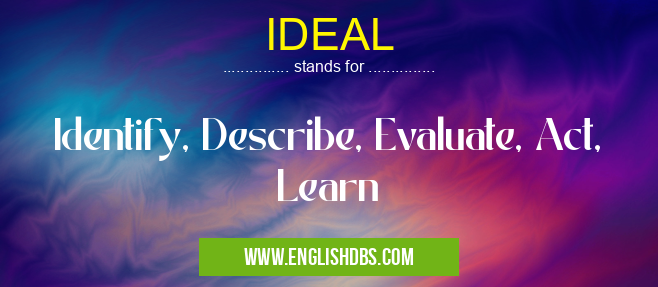What does IDEAL mean in EDUCATIONAL
IDEAL is an acronym used to help people remember essential steps for making decisions and solving problems. It stands for Identify, Describe, Evaluate, Act, and Learn. By following these steps, people are better able to think through complex issues and come up with effective solutions.

IDEAL meaning in Educational in Community
IDEAL mostly used in an acronym Educational in Category Community that means Identify, Describe, Evaluate, Act, Learn
Shorthand: IDEAL,
Full Form: Identify, Describe, Evaluate, Act, Learn
For more information of "Identify, Describe, Evaluate, Act, Learn", see the section below.
» Community » Educational
Essential Questions and Answers on Identify, Describe, Evaluate, Act, Learn in "COMMUNITY»EDUCATIONAL"
What does IDEAL stand for?
IDEAL stands for Identify, Describe, Evaluate, Act, and Learn.
Why is it important to follow the steps of IDEAL?
Following the steps of IDEAL helps people think through difficult problems in a systematic way and come up with the best solution possible.
How do these five steps work together?
The five steps of IDEAL form a logical sequence that moves from identifying an issue to learning from experience. After identifying the issue that needs to be addressed (Identify), it's important to describe it in detail (Describe). Then you can evaluate all potential solutions (Evaluate) before deciding on a course of action (Act). Finally, you can assess whether the chosen solution was effective or not (Learn).
What are some examples of how IDEAL could be used?
IDEAL could be applied in a variety of situations such as choosing a college major, starting a business venture or selecting a new home. In each case, you would identify your goals carefully; describe the situation in detail; evaluate potential solutions; choose one based on your evaluation; then learn from any successes or mistakes you make along the way.
What other tools might be helpful when usingIDEAL?
Other tools that could be helpful when usingIDEAL include brainstorming techniques such as mind-mapping or SWOT analysis; decision-making methods such as cost-benefit analysis; and creative problem solving approaches like reverse engineering or systems thinking.
Final Words:
Using the IDEAL approach can help people make thoughtful decisions and solve complex problems effectively by breaking them down into manageable parts. By utilizing additional decision-making tools and creative problem solving strategies alongside IDEAL, people can develop more comprehensive solutions that address all aspects of the situation at hand.
